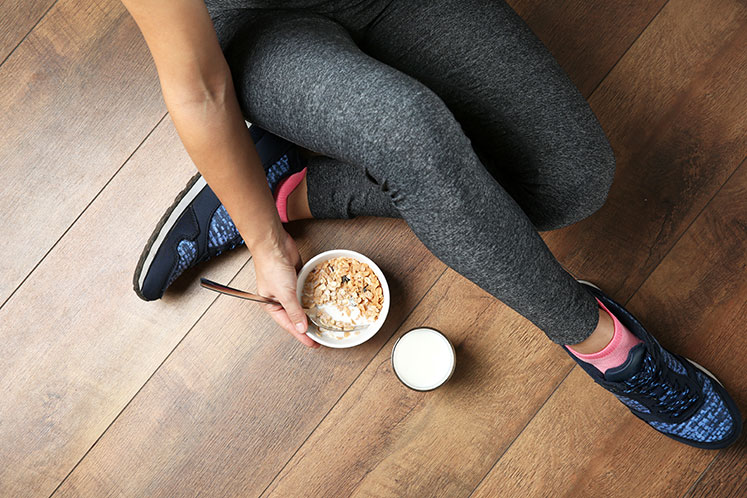Find out about simple lifestyle measures that can help prevent osteoporosis.
November is osteoporosis awareness month. Learn about about eight ways to reduce your risk of developing osteoporosis.
What is osteoporosis?
Osteoporosis is a disease that makes your bones weak and porous (like a sponge.) As a result, individuals who have osteoporosis are at an increased risk of fracturing their bones, especially if they fall. Osteoporosis is sometimes referred to as the “silent disease”, as bone deterioration can occur over several years without any noticeable changes to your health. In fact, the first indication of osteoporosis is often when a bone breaks. At this point, the disease is fairly advanced. Read about the osteoporosis risk factors to learn if you are at an increased risk of developing osteoporosis.
When does osteoporosis develop?
Many Canadians believe osteoporosis is a disease that only affects older people. The reality is that osteoporosis is a condition that starts in childhood. The pre-teen and teenage years are a once-in-a-lifetime chance to build bones. Taking steps to build bone health while you are young can literally make or break what will happen to your bones as you age. By the time we reach our early 20s, our bones will be the strongest they will ever be. That doesn’t mean we need to stop thinking about our bones as we get older. Bone tissue is continually being replaced. In fact, the bone we have in our bodies today didn’t even exist in our bodies 10 years ago!
As a result, no matter what our age, we need to make healthy choices that support bone health.
What can I do to help prevent osteoporosis?
1. Get enough calcium
Calcium is the major nutrient needed to form new bone cells, making it vital for bone health. Bones store more than 99% of the calcium in your body so you can think of your bones as a calcium bank. If you don’t get enough calcium every day, then your body will make a withdrawal from the calcium bank, which can leave bones porous and weak.
Calcium recommendations change at different stages of life, as seen below:
Age in Years |
Recommended Calcium Intake per Day |
| 1 – 3 | 700 mg |
| 4 – 8 | 1000 mg |
| 9 – 18 | 1300 mg |
| 19 – 50 | 1000 mg |
| 51 – 70 | 1000 mg for men*; 1200 mg for women |
| 70+ | 1200 mg |
| Pregnant or lactating women 19+ | 1000 mg |
Source: National Academy of Sciences. Dietary Reference Intakes for Calcium and Vitamin D, 2010.
* Osteoporosis Canada recommends 1200 mg of calcium/day for men over 50.
Some calcium-rich foods include:
- Milk
- Yogurt
- Cheese
- Fortified soy drink
- Canned salmon and sardines with bones (the calcium is in the bones)
- Soybeans
- Some dark green leafy vegetables, such as cooked collards, kale and bok choy
- Calcium-fortified tofu
Other calcium-rich foods can be found here.
It is important to note that the majority of Canadians (adults and children) are not consuming the recommended amount of calcium every day. Check out our interactive Calcium Calculator™ to find out if you are getting enough every day!
Experts agree that getting calcium from food is the best option. If it is not possible to get enough calcium through diet alone, a supplement may be helpful. It’s important to speak to a doctor, pharmacist, or dietitian about calcium supplements, as they can have negative side effects. Extra calcium from foods is not harmful; however, extra calcium from supplements can be. If you are already getting enough calcium in your diet, there is no need to take a supplement.
2. Get enough Vitamin D
Vitamin D helps your body use and absorb calcium. It also improves muscle function, which can improve your balance and decrease the likelihood of falling and consequently breaking a bone. Vitamin D is produced when skin is exposed to the sun and it is also found in some foods. Due to Canada’s low sun exposure for many months of the year, and the fact that most foods are poor sources of Vitamin D, supplementation is recommended year-round for Canadian adults.
Vitamin D recommendations change at different stages of life, as seen below:
Age in Years |
Daily Vitamin D Recommendations |
| 1 – 70 | 600 IU |
| 71+ | 800 IU |
| Pregnant or lactating women | 600 IU |
Source: National Academy of Sciences. Dietary Reference Intakes for Calcium and Vitamin D, 2010.
* These recommendations include vitamin D from food and supplements.
* Osteoporosis Canada recommends 400–1000 IU for individuals up to age 50 and 800–2000 IU for adults over age 50.
Common Food Sources of Vitamin D:
- Fish
- Milk
- Egg yolks
- Fortified soy drink
- Margarine
3. Consume adequate protein
Protein is another key nutrient for bone growth, maintenance and renewal. Protein and calcium interact closely with one another so it is important that enough protein and calcium are consumed to fully realize the benefit of each nutrient on bone.
Check to see if you are getting enough protein by using the FoodTrack—Check on Protein interactive brochure!
4. Limit high sodium foods
Sodium doesn’t affect your overall calcium balance if you are getting enough calcium. However, if you are not getting sufficient calcium, eating foods that contain high sodium levels can cause your body to lose calcium and can lead to bone loss. For tips on how to limit sodium intake, click here.
5. Drink caffeine sensibly
Consuming too much caffeine can decrease the amount of calcium that your body absorbs and stores. Try to have no more than 400 mg of caffeine per day [approximately 4 (8 oz) cups of coffee]. Don’t forget that caffeine is also found in drinks such as colas and energy drinks in large amounts. Tea contains a low to moderate amount of caffeine as well. Check out FoodTrack—Check on Caffeine to see if you are on track.
6. Limit alcohol
Drinking heavily on a regular basis can lead to bone loss and increase chances of developing osteoporosis. Women should stick to no more than 2 drinks per day or 10 per week and men should limit themselves to no more than 3 drinks per day or 15 per week.
One drink is:
- 5 oz glass of 12% wine
- 12 oz bottle of 5% beer
- 1 ½ oz shot of 40% spirits
7. Stay active
Regular physical activity, including any weight-bearing exercises, like walking, can help decrease your risk of developing osteoporosis.
It is important to note that being physically active doesn’t just mean playing sports or going to the gym. Other activity ideas include:
- Dancing around the house
- Heavy gardening
- Playing tag with your kids
- Biking to work
- Rock-climbing
- Running with friends
One of the best ways to get started with exercise and remain active is to set S.M.A.R.T goals. S.M.A.R.T. goals are goals that are Specific, Measurable, Attainable, Realistic and Time-oriented. Click here to learn more about how you can set S.M.A.R.T goals for your physical activity!
Guidelines for daily physical activity are seen below:
Age in Years |
Physical Activity Recommendation |
| 1 – 4 | 180 minutes per day |
| 5 – 17 | 60 minutes per day |
| 18 – 64 | 150 minutes per week |
| 65+ | 150 minutes per week |
8. Avoid smoking
At any age, smoking can increase bone loss. For information on how to quit, click here.
Take charge now
Start small by finding an idea or two that sparks your interest. All of the ideas listed above promote health in a variety of ways and every little bit helps!
By Carmen Gorlck, RD
Updated November 2019

References
- Osteoporosis Canada. (2018). What is Osteoporosis? Retrieved from: https://osteoporosis.ca/
- Canadian Society for Exercise Physiology. (2011). Canadian 24-Hour Movement Guidelines: An Integration of Physical Activity, Sedentary Behaviour, and Sleep. Retrieved from: http://csepguidelines.ca/guidelines-for-pregnancy/
- Weaver, CM. (2018). Calcium in health and disease: What is enough and how do we get it? [Powerpoint slides]. Retrieved on May 22, 2018 from: https://bcdairy.ca/nutritionforum/presentations/forum2018
- Canadian Centre on Substance Use and Addiction. (2018). Drinking Guidelines. Retrieved from: http://www.ccdus.ca/Eng/topics/alcohol/drinking-guidelines/Pages/default.aspx
- National Academy of Sciences. Dietary Reference Intakes for Calcium and Vitamin D, 2010.
- Health Canada. (2011). Eating Well with Canada’s Food Guide. Retrieved from: https://www.canada.ca/content/dam/hc-sc/migration/hc-sc/fn-an/alt_formats/hpfb-dgpsa/pdf/food-guide-aliment/view_eatwell_vue_bienmang-eng.pdf



